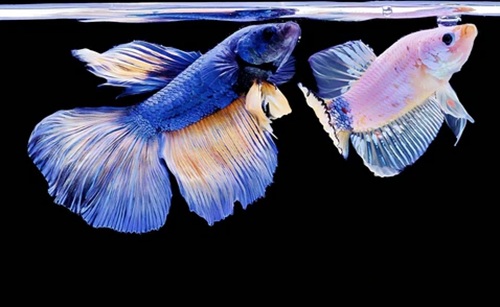For fish enthusiasts, breeders, and aquarium hobbyists, distinguishing between male and female fish is essential for breeding, maintaining a healthy population, and understanding fish behavior. While in some species the differences are subtle, in others they are quite pronounced. Proper identification ensures successful breeding and helps avoid aggression, overpopulation, or stress in aquariums.

1. Understanding Sexual Dimorphism in Fish
- Sexual dimorphism refers to the physical differences between male and female fish of the same species.
- These differences can appear in size, color, fin shape, body structure, and behavior.
- Not all species show obvious dimorphism; some require careful observation or even professional techniques like venting.
2. Size Differences
- In many fish species, females are larger and rounder because they carry eggs.
- Males are often smaller and slimmer, built for agility and chasing females during mating.
- Example: In guppies, females are larger and have a rounded abdomen, while males are smaller and more slender
3. Coloration and Patterns
- Male fish frequently have brighter colors and distinctive patterns to attract females.
- Female fish usually have duller or camouflaged colors, which helps them hide from predators while carrying eggs.
- Example: Betta fish males display bright, vibrant colors and long flowing fins, whereas females are paler and have shorter fins.
4. Fin Shape and Size
- Males often have longer, more elaborate fins compared to females.
- Females typically have shorter, rounder fins suitable for egg-laying and swimming efficiently.
- In species like angelfish, the male’s dorsal and anal fins are more pointed, while females’ fins are rounded.
5. Body Shape and Abdomen
- Female fish may have a rounded or swollen abdomen, especially when carrying eggs.
- Males have streamlined bodies to chase and court females.
- Example: In goldfish, females look plumper during breeding season, while males remain slender.
6. Behavioral Differences
- Male fish often show territorial or aggressive behavior, particularly during breeding season.
- They may chase females or other males, display courtship dances, or build nests.
- Female fish usually stay in groups, focusing on feeding and egg-laying.
- Example: Male guppies display tail-spread courtship behavior, while females observe or evade initially.
7. Special Breeding Features
Some species have unique anatomical features that make identification easier:
- Guppies and Mollies: Males have a modified anal fin called the gonopodium, used for fertilization.
- Swordtails: Males have a “sword-like” extension on their tail fin; females do not.
- Livebearers vs Egg-Layers: In livebearers, males are more streamlined with specialized fins, while in egg-layers, females are plumper
8. Techniques for Subtle Species
- Venting Method: Gently inspect the genital papilla located near the anal fin. Males are pointed; females are rounded.
- Observation During Breeding: Males display courtship behavior, while females respond by releasing eggs.
- Professional Tools: In some rare or subtle species, aquarists may use magnifying tools or expert advice for accurate identification.
Quick Comparison Table: Male vs Female Fish
| Feature | Male Fish | Female Fish |
| Size | Smaller, slender | Larger, plumper |
| Color | Bright, vibrant | Dull, muted |
| Fins | Longer, more elaborate | Shorter, rounded |
| Abdomen | Streamlined | Rounded, swollen during breeding |
| Behavior | Aggressive, territorial | Passive, stays in groups |
| Special Features | Gonopodium, tail extensions | None or subtle |
Final Thoughts
Identifying male and female fish is a crucial skill for aquarium enthusiasts, breeders, and researchers. By observing size, color, fin shape, body structure, and behavior, you can distinguish between the sexes in most species. Accurate identification allows for successful breeding, healthier fish populations, and a more balanced aquarium environment. For beginners, start with common species like guppies, bettas, or goldfish, where differences are easier to spot, and gradually learn the subtleties in more exotic fish.